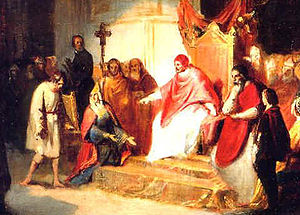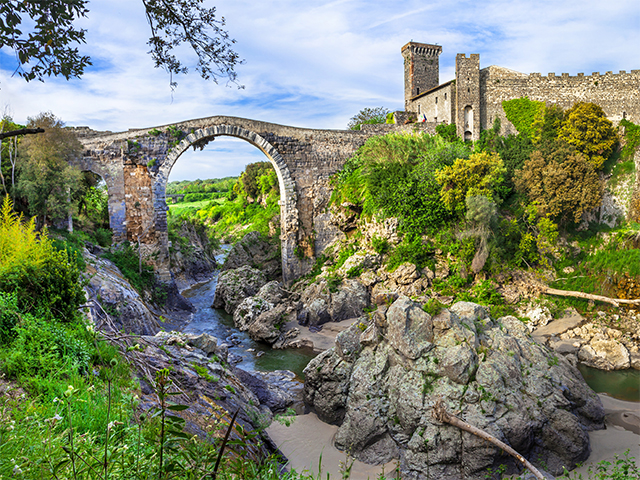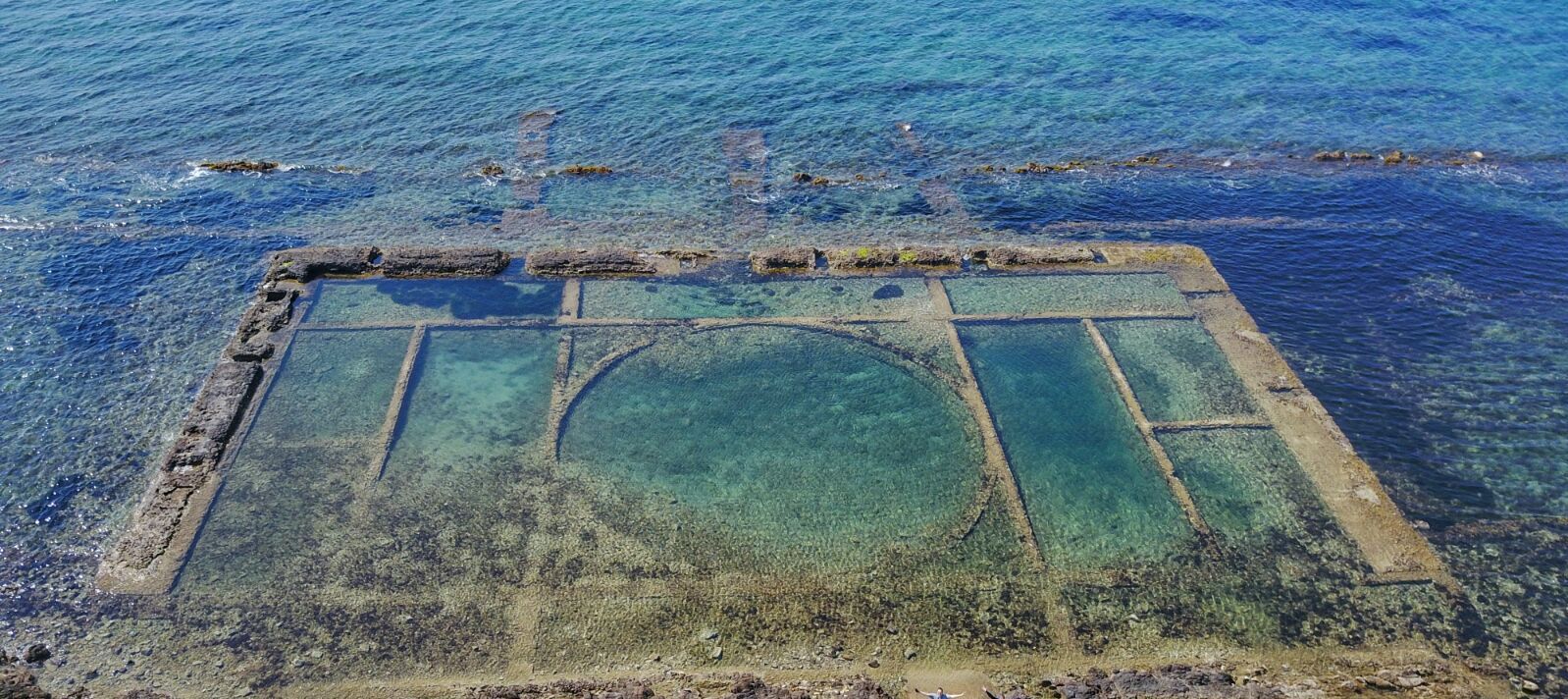 The Walk to Canossa (sometimes called the Way to Canossa; German, Gang nach Canossa; Italian,l'umiliazione di Canossa) refers to both the trek itself of Henry IV of the Holy Roman Empire from Speyer to the fortress at Canossa in Emilia Romagna and to the events surrounding his journey, which took place in and around January 1077.
The Walk to Canossa (sometimes called the Way to Canossa; German, Gang nach Canossa; Italian,l'umiliazione di Canossa) refers to both the trek itself of Henry IV of the Holy Roman Empire from Speyer to the fortress at Canossa in Emilia Romagna and to the events surrounding his journey, which took place in and around January 1077.
When, in his early papacy, Gregory VII attempted to enact reforms to the investiture process, he was met by much resistance from the Holy Roman Emperor. Henry insisted that he reserved the right to "invest" bishops and other clergymen, despite the papal decree. Henry renounced Gregory as pope; in return, Gregoryexcommunicated and deposed Henry, in the Lenten synod of 1076, at Rome. He stated furthermore that, one year from that day, the excommunication would become permanent and irrevocable.
Violence had already broken out at Langensalza on 9 June 1075, suppressed by Henry. Now the patriarch of Aquileia and the papal legate met with German princes at Oppenheim, 16 October 1076, and swore an oath not to recognize Henry unless the ban were lifted. Fearing further rebellion among the German aristocracy, Henry felt he had to have his excommunication lifted. On the suggestion of his adversaries, he arranged to meet with the pope in Augsburg.
Gregory, however, feared that Henry would bring his army and attempt to remove the pope from power. He spent some time on his journey northward from Rome in Italian towns that owed fealty to the Holy Roman Empire, trying to gain support among the people and assessing his strengths among the churchmen.
While still in the northern reaches of present-day Italy, he met Mathilda, Countess of Tuscany. She offered to bring him to a location safe from attack by Henry. They traveled together to the fortress at Canossa and shut themselves inside.
Henry commenced his trip in Speyer and travelling southward from Germany, he found his position precarious. He was still popular among the common people, but his nobles were still threatening to elect a new king. He had to secure his position in the church before the rapidly approaching deadline given by the pope.
Once he crossed the Jura Mountains by the Mont Cenis pass, Henry took on the behavior of penitence. He wore a hair-shirt, the traditional clothing of monks at the time, and allegedly walked barefoot. Many of his entourage also supposedly removed their shoes. In these conditions he crossed the Alps, a long and harsh journey in late January. On 25 January 1077 he reached the gates of Canossa.
When Henry reached Canossa, the Pope ordered that he be refused entry. According to the first-hand accounts of the scene (letters written by both Gregory and Henry in the following years), Henry waited by the gate for three full days. During this time, he allegedly wore only his penitent hair shirt and fasted. Although no contemporary sources report this, it has since been speculated that Henry spent much of his time during these three days in the village at the foot of the hill.
On 28 January the gates were opened for Henry and he was allowed to enter the fortress. Contemporary accounts report that he knelt before Pope Gregory and begged his forgiveness. Gregory absolved Henry and invited him back into the Church. That evening, Gregory, Henry, and Mathilda shared communion in the Cathedral of Saint Nicholas inside the fortress, signaling the official end of Henry's excommunication.
Henry quickly returned to his empire, but Gregory remained with Mathilda at the fortress and in other locations in Tuscany for several months. Later historians speculated upon a romantic or sexual relationship between the two (an accusation sometimes raised by Protestant historians in the 17th century) although if there was ever any evidence for this it has not survived.
The immediate effects of the Canossa meeting were limited. Although Henry was restored to the Church, any expectations that the Pope would restore support of Henry's right to the throne were soon dashed: in March, a small group of powerful Saxon and South German territorial magnates, including the archbishops of Salzburg, Mainz and Magdeburg and several bishops, met at Forchheim and, on the assumption that Henry had irretrievably lost the imperial dignity, repudiated the Salian dynasty's claim to pass the imperial crown by heredity and, in the words of Bruno of Merseburg, present in his bishop's entourage. "that the son of a king, even if he should be preeminently worthy, should become king by a spontaneous election". The Pope confirmed the agreement. His deposition still in effect, Henry was forced into civil war with Duke Rudolph of Swabia. Gregory levied a second excommunication against Henry, who ultimately won the civil war, invaded Rome, and forced Gregory to flee, replacing him with Antipope Clement III.
The meaning in the greater history of Germany and Europe, however, was much more significant. During the Protestant Reformation in the 16th century, Henry was exalted as a defender of the rights of both Germans and opponents of the Pope. Many German Lutherans considered him the "first Protestant" and looked to his example for guidance in their struggle against what they saw as a tyrannical and unjust institution.
Later in German history the event took on a more secular meaning: it came to stand for Germany's refusal to be subjected to any outside power (although still especially, but not exclusively, the Roman Catholic Church). Otto von Bismarck, during his so-called "Kulturkampf," assured his countrymen that "We will not go to Canossa – neither in body nor in spirit!" That is, Germany would stand for itself and not abide any outside interference in its politics, religion or culture.
On the other side, Canossa is remembered in Italy by some historians (like Benedetto Croce) as the first concrete victory of the Pope (who represented the Italian people) against the domination of the Germans after the fall of the Roman Empire. Croce considered Canossa as the initial retreat from Italy of the Holy Roman Empire, starting the Italian Renaissance in which the Germans lost control of northern Italy by the 15th century.
Today, "Canossa" refers to an act of penance or submission. To "go to Canossa" is an expression – used often in German: "nach Canossa gehen", in Danish, Norwegian and Swedish: "Canossavandring" or "Kanossagang", in French: "aller à Canossa", and in Italian: "andare a Canossa" – to describe doing penance, often with the connotation that it is unwilling or coerced. Adolf Hitler, for instance, used the expression to describe his meetings with Bavarian Minister President Heinrich Held after being released from Landsberg Prison, in his bid to have the ban on the Nazi Party lifted.
Discover about Mathilda and see her burial monument at the Vatican Tour






